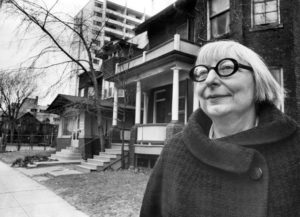
Jane Jacobs outside her home on Spadina Road just north of Bloor Street in Toronto. Photo taken by Frank Lennon/Toronto Star Dec. 21, 1968.
I’m enjoying reading articles here, here and here about Jane Jacobs, who would have been 100 years old today. Born in 1916, she was a self-taught urbanist and citizen activist who championed walking-scaled, neighborhood-centered cities. Though she had no college degree or professional training, she took on the power brokers of New York’s urban renewal policies of the 1950s and forced planners and economists to rethink their practices. Her 1961 treatise, The Death and Life of Great American Cities, introduced groundbreaking ideas about how cities become places of community vitality, why they break down and how they could be better structured.
In the early 1960s, as planners were dividing cities into single-use, car-based zones – think shopping centers, high-rise offices and suburban housing – Jacobs believed that cities were better having a mixed up messiness about them. She described cities as “problems of organized complexity” and as ecosystems with their own logic and dynamism, evolving and changing over time. She described how sidewalks, parks, neighborhoods, government and economy function together synergistically, like a natural ecosystem. She observed the complex interdependencies, diversity and niches that promote resilience and vitality.
Jacobs was critical of top-down planning approaches that thought in terms of static and insensitive master plans, over-scaled development and separated uses. She felt strongly that local residents should have input into how their neighborhoods develop, and gave them tools to understand the intricacies of their communities. She argued for mixed-use development, streets with buildings of mixed ages, and short blocks to bring the scale of the local neighborhood in line with the finely grained dimension of social life.
Michael Mehaffy, a friend, author and planner, wrote of Jane Jacobs’ legacy this way:
In the end, Jacobs’ message was a hopeful one. We broke cities – we broke our built environment – and we can fix it. We do have the power to make walkable, thriving cities and towns, and to erase the disastrous course of suburban fragmentation we set ourselves on several generations ago. The kind of problem a city is, is one that can, in fact, be solved – if we understand it, and learn from it.
— Ross Chapin

